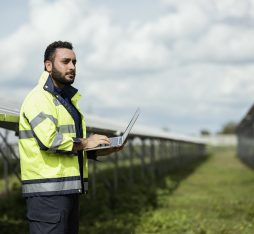“This solution doesn’t require image storage or transmission over networks and involves local data processing, which means excellent security and privacy.”
As powerful as they are, existing video analytics solutions for managing parking lots still have a few road blocks to get past. They may require smart cameras, which do not come cheap, or they may need to use networks to send large amounts of data to the Cloud for processing on a remote server. But by combining edge computing and video analytics technologies, we can improve this model and produce a system that is just as efficient, but more secure and adaptable — one which can be used with the cameras that are there already.
A Local, Closed-Loop Processing System
The solution from Orange’s teams in Poland can be deployed in parking lots fitted out with standard cameras. The difference between their system and other services for detecting parking availability lies in its architecture. In this case, the video stream is analyzed at the network edge, on the client side, as close to the cameras as possible. “Image processing takes place on-site,” explain Orange R&D experts Wojciech Niewolski and Przemysław Ratuszek. The camera feed is sent over a local point-to-point connection to an on-site edge computing unit, where it is analyzed using advanced algorithms. Nothing is uploaded to the Cloud. The small amount of data that is sent over the networks is raw and anonymized. When this data arrives at our IoT Live Objects platform, it generates parking availability indicators, dashboards and so on. The solution is highly secure and private, as there is no need for image storage or transmission over networks.” It also leaves you with a much better ratio of bandwidth consumption to use.
This solution doesn’t require image storage or transmission over networks and involves local data processing, which means excellent security and privacy.
A Flexible and Scalable System
Another major draw for customers, be they companies or local authorities, is how flexible the solution and its underlying architecture are. Hardware-wise, as mentioned above, basic cameras are all you need to implement this solution, which can be extended to multiple use cases if needed, unlike a smart camera, which can only perform one function. The system is also versatile in terms of its “brainpower”. Although it is currently based on machine learning algorithms for object detection known as YOLO algorithms, the solution’s intelligence can be developed in line with customer’s use habits and expectations. The plug-in architecture means new AI modules and building blocks can be added quickly and easily to enhance performance and precision, or even change the nature of the service provided. This means that market or tailor-made video analytics algorithms can be added on request, such as optical character recognition (OCR) processes for detecting cars’ license plates.
Many Potential Applications
Orange’s teams in Poland are also looking to explore new application areas, besides car parking. They will run a PoC (proof of concept) at the Smart Store in Warsaw to try out using the solution for counting customers and analyzing of areas of particular interest in the store. Niewolski and Ratuszek explain that although “the platform is now focused on video, the research behind it was initially looking into audio processing. The original aim was to detect and locate drones in specific areas, using audio streams from standard microphones, like the ones you find in smartphones.”
So, the platform has shifted to a different application area to meet customers’ needs, but it can still offer the same type of services for audio and data. And more generally, it is ready to play an active part in the Smart City movement and ecosystem.




